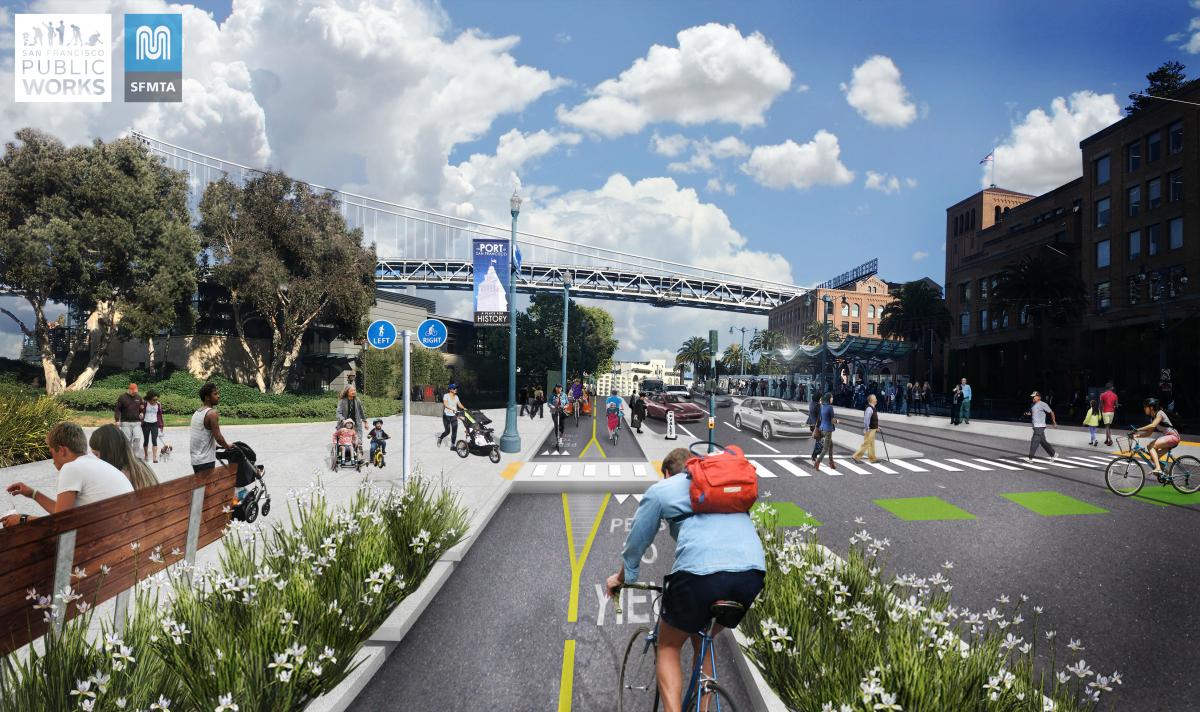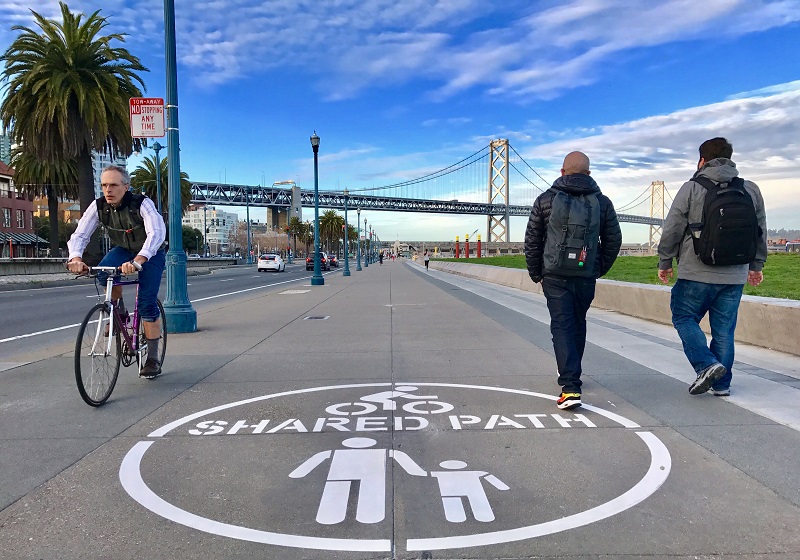A New Vision for The Embarcadero’s Streetscape - Concept Design Showcase
Today, the SFMTA is sharing a new concept vision for The Embarcadero, one of the city's most popular and iconic corridors. This vision, with separated spaces for people walking, biking and driving, is the result of a deep community outreach and design process that began in 2014 as part of the SFMTA’s Embarcadero Enhancement Project.
In partnership with the Port of San Francisco and San Francisco Public Works, this initiative will increase safety and comfort for everyone travelling along The Embarcadero. The corridor is currently on San Francisco’s High Injury Network, where 75 percent of the city’s traffic fatalities and severe injuries occur on just 13 percent of our streets.
Over the course of four years, the city consulted with The Embarcadero’s residents, businesses, workers and travelers to understand their needs and shape a collective vision for a safer, more functional Embarcadero.
Together, we are reimagining The Embarcadero’s streetscape as a better place to walk and bike along San Francisco’s picturesque waterfront, made possible by a two-way bikeway on the waterside of the street from Townsend to North Point streets.

Concept Design Showcase - October 25
The concept design will be explored in-depth at a project showcase on October 25 (5:00 p.m. – 7:30 p.m.) in the Grand Hall Atrium on the second floor of the Ferry Building. The event is open to the public and all are invited to come. More details about the showcase are now online.
At the showcase, attendees can review the concept’s details, learn about upcoming improvements and share feedback on other proposed elements in the concept design, such as potential circulation changes, curb space management and transit-focused upgrades.
While this concept design presents a vision, more detail is needed to bring it to reality. After completing the conceptual design phase this fall, next steps will include environmental review, detailed design, and identifying project phasing and funding sources.
These efforts will help the city focus decision-making on key project details, better understand the project’s constructability and cost, and determine how efforts can be aligned with any future construction projects the Port of San Francisco and its tenants have planned.

Safety Upgrades Completed And On The Horizon
The Embarcadero is one of San Francisco’s most iconic destinations. It serves as a thriving business corridor, critical transportation artery, key tourism landmark and popular recreational route all at the same time.
This often makes The Embarcadero feel disorganized and over-subscribed, particularly with the advent of ride-hailing and other new mobility options, as well as the rapid growth of adjacent neighborhoods. With so many people using The Embarcadero on a daily basis, many users report that it feels unsafe or uncomfortable at times. Worse, The Embarcadero suffers from a disproportionate number of traffic collisions.
Much of the roadway appears on San Francisco’s High Injury Network, the 13 percent of city streets where 75 percent of our severe and fatal traffic injuries occur. Just last month, Kevin Manning, was tragically killed while operating a pedicab on The Embarcadero. The reckless, hit-and-run driver is still at large and the SFPD is seeking public assistance.
Through the city’s Vision Zero goal of eliminating traffic fatalities, the SFMTA has been making targeted safety investments on the streets where we see the most traffic injuries and fatalities. Each year, we have committed to making engineering improvements on at least 13 miles of the High Injury Network. In 2017 alone, the SFMTA constructed 77 miles of safety improvements, 34 miles of which were on this network.
We aren’t waiting on the long-term Embarcadero Enhancement Project to make the safety improvements needed now. For example, last year the agency implemented a variety of traffic safety improvements on The Embarcadero to create safer streets quickly.
Additional efforts to improve safety in the near future are underway. By the end of this year, the SFMTA will remove the part-time bike lane between Broadway and Mission streets and replace it with a full-time bike lane and all-day parking lane. The agency will also identify locations for additional paint, markings or posts to increase safety for people walking and biking, as well as create a more organized roadway.
Working With Our Communities To Design A Better Embarcadero
The safety improvements completed and planned are the direct result of the agency’s robust community outreach process. While four years can seem like a long time to reach consensus and a design, this process is aligned with the size and scale of the project itself.
The Embarcadero Enhancement Project study area spans nearly three miles, from AT&T Park at King Street to the Fisherman’s Wharf area. The corridor isn’t just long, it’s technically complex with varying widths and travel demand along each block. A diversity of communities rely on a safe and functional Embarcadero and numerous factors must be considered, from loading for local businesses and parking availability to passenger drop-off and emergency access. The concept design reflects both community feedback, as well as a preliminary technical analysis conducted by the SFMTA.
Designing significant changes to one of San Francisco’s longest and most iconic landmarks requires time, effort and inclusive engagement. Reaching the concept design milestone could not have been possible without the breadth and depth of community input the city received and we look forward to continued work with the public to bring this vision into reality as fast as possible.
